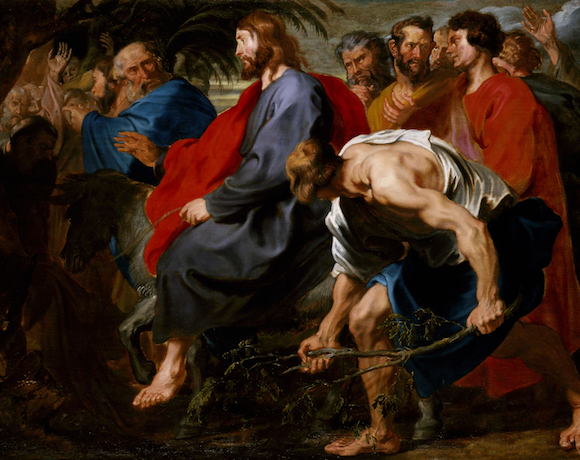
Palm Sunday
Palm Sunday marks the opening of the most dramatic, most important, and most holy time of the Christian year, for we celebrate the great mystery of our salvation sacramentally entering the events of the Sacred Triduum. 
The types and shadows of the Old Testament are made manifest this week, and today, as Christ enters Jerusalem, the words of Psalm 68 are fulfilled, Thy solemn processions are seen, O God, the processions of my God, my King, into the sanctuary (verse 24). By entering sacramentally into this week, we live out the words of this psalm, Thou didst ascend the high mount, leading captives in thy train, and receiving gifts among men, even among the rebellious, that the Lord God may dwell there (v. 18). We follow Christ in his train as he makes his way to the Cross, to rise with him from death to life. Our God is a God of salvation; and to God, the Lord, belongs escape from death (v. 20).
Christ is not forced into His Passion, but enters it freely, and, for the moment at least, is welcomed by the people of Jerusalem as he enters His city, Thy solemn processions are seen, O God, the processions of my God, my King, into the sanctuary, the singers in front, the minstrels last, between them maidens playing timbrels: “Bless God in the great congregation, the Lord, O you who are of Israel’s fountain!” There is Benjamin, the least of them, in the lead, the princes of Judah in their throng, the princes of Zebulun, the princes of Naphtali (vv. 24-27).
There are many layers of meaning in the events of Holy Week, and just as events from the Old Testament prefigure the events of this week, so events earlier in the week prepare us for those later in the week. Palm Sunday prepares us for another royal procession which is to take place on Thursday evening. As the Lord prepares to face His Passion, he crosses the Brook of Kidron, to the Garden of Gethsemane to pray to the Father to let the chalice pass from him; this great moment of suffering prayer finds echoes in the Old Testament, where David and the people of Jerusalem cross the valley as they leave Jerusalem for the wilderness, running from Absalom (2 Samuel 15:23). This sad and solemn procession will be ours as we make our way to the Altar of Repose on Holy Thursday.
The following morning, Christ enters upon his great procession to Calvary carrying His Cross. We are called to undertake this procession each day of our lives as we display the wisdom of God to the world, For I think that God has exhibited us apostles as last of all, like men sentenced to death; because we have become a spectacle to the world, to angels and to men (1 Corinthians 4:9). On Good Friday we enter this mystery in that most special way as we process to the sanctuary to kiss the feet of our Crucified Lord.
Finally, we enter into the sufferings of our Blessed Mother, who takes the lifeless body of her Son into her arms, and takes him in solemn procession to the tomb. But what is hidden from sight at this moment is that what seems like such failure, is actually a moment of great triumph. The clods of the valley are sweet to him; all men follow after him, and those who go before him are innumerable (Job 21:33). Even in death and a procession to burial, the clods of the valley below Golgotha are sweet to our Lord now, and we, invisible to those there on that first Good Friday, follow after our Crucified Lord and make ready to watch at the tomb as he sets about freeing those innumerable souls who have gone before Him in death.
Sorry, the comment form is closed at this time.



A Website Visitor
Who painted the Palm Sunday picture please? Rubens? Interesting iconography.